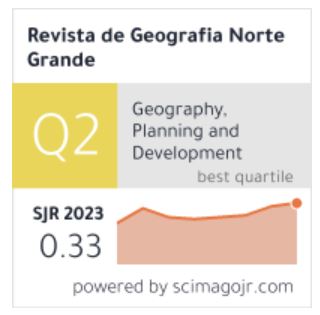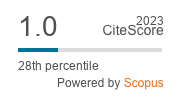El Clima desértico costero con nublados abundantes del desierto de Atacama y su relación con los recursos naturales energía solar y agua de niebla.
Caso de estudio Alto Patache (20,5°S), región de Tarapacá, Chile
DOI:
https://doi.org/10.4067/S0718-34022017000300033Keywords:
irradiance (W/m2), Advective and Orographic Fog, Renewable Natural ResourcesAbstract
Considering the increase of water and energy requirements in arid zones, this work combine the presence of the coastal stratocumulus as a potential water resource and the behavior of solar radiation as an energy source. The aim is to know the relationships between attenuation of irradiance by fog typology (orographic or advective) and the yields of associated fog water. September 2013 was analyzed using GOES satellite images, data from the Standard Fog Collector (SFC) and the radiometer located at the Atacama UC Station, Oasis de Niebla Alto Patache (20 ° 49 'S - 70 09'O -800 m a.s.l.). Results show complementarity between the daily cycles of these resources and their productive hours of water and energy (night and day) respectively. This research motivates subsequent studies on fog water and solar energy as complementary resources in line with implementing technologies for wáter treatment, management and distribution, as well as solar panel dust cleaning.
Downloads
References
ANTHIS, A. & CRACKNELL, A.P. Use of satellite images for fog detection (AVHRR) and forecast of fog dissipation (METEOSAT) over lowland Thessalia, Hellas. Int J Remote Sens, 1999, Vol. 20, N° 6,
p. 1107-1124.
BANCO MUNDIAL. Chile. Diagnóstico de la gestión de los recursos hídricos. Departamento de Medio Ambiente y Desarrollo Sostenible, Región para América Latina y el Caribe, 2011, p. 81.
BENDIX, J. A satellite-based climatology of fog and low level stratus in Germany and adjacent areas. Atmos, 2002, Vol. 64, N° 1-4, p. 3–18.
BIRD, R.E. & HULSTROM, R.L. A Simplified Clear Sky Model for Direct and Diff use Insolation on Horizontal Surfaces. SERI/TR-642-761. Golden, CO: Solar Energy Research Institute, 1981.
CÁCERES, L.; GÓMEZ-SILVA, B.; GARRÓ, X.; RODRÍGUEZ, V.; MONARDES, V. & MCKAY C.P. Relative humidity patterns and fog water precipitation in the Atacama Desert and biological implications, Journal of Geophysical Research, 2007, Vol. 112, N° G4. Disponible en internet: http://onlinelibrary.wiley.com/doi/10.1029/2006JG000344/pdf
CENTRO DE INVESTIGACIÓN Y DESARROLLO EN RECURSOS HÍDRICOS, CIDERH. Recursos hídricos Región de Tarapacá. Iquique: Ediciones Universidad Arturo Prat, 2013.
CERECEDA, P.; OSSES, P.; LARRAÍN, H.; FARÍAS, M.; LAGOS, M.; PINTO, R. & SCHEMENAUER, R.S. Advective, orographic and radiation fog in the Tarapacá region, Chile. Atmospheric Research, 2002, N° 64, p. 261-271.
CERECEDA P.; LARRAÍN, H.; OSSES, P.; FARÍAS, M. & EGAÑA, I. The climate of the coast and fog zone in the Atacama Desert of Tarapacá Region, Chile. Atmospheric Research, 2008a, N° 87, p. 301-311.
CERECEDA, P.; LARRAIN, H.; OSSES, P.; FARÍAS, M. & EGAÑA, I. The spatial and temporal variability of fog and its relation to fog oases in the Atacama Desert, Chile. Atmospheric Research, 2008b, N° 87, p. 312-323.
CNE/PNUD/UTFSM. Irradiancia solar en territorios de la República de Chile. Santiago de Chile: Registro solarimétrico, 2008, p. 248.
DEL RÍO, C.; GARCIA, J.L.; OSSES, P.; ZANETTA, N.; LAMBERT, F.; RIVERA, D.; SIEGMUND, A.; WOLF, N.; CERECEDA, P.; LARRAÍN, H. & LOBOS, F. ENSO influence on coastal fog-water yield in the Atacama Desert, Chile. Aerosol and Air Quality Research, 2017. DOI: 10.4209/aaqr.2017.01.0022
DIRECCIÓN METEOROLÓGICA DE CHILE. Informe de precipitaciones. 2017. Disponible en Internet: http://www.meteochile.gob.cl/PortalDMC-web/index.xhtml
ELLROD, G. Advances in the Detection and Analysis of Fog at Night Using GOES Multiespectral Infrared Imagery. Weather & Forecasting, 1995, N° 10, p. 606-619.
ESCOBAR, R.; CORTÉS, C.; PINO, A.; SALGADO, M.; PEREIRA, E.; RAMOS-MARTINS, F.; BOLAND, J. & CARDEMIL, J. Estimating the potential for solar energy utilization in Chile by satellite-derived data and ground station measurements. Solar Energy, 2015, Vol. 121, p. 139-151.
EYRE, J.R. (Detection of fog at night using Advanced Resolution Radiometer (AVHRR) imagery. Meteor. Mag., 1984, N° 113, p. 266-271.
FARÍAS, M.; CERECEDA, P.; OSSES, P. y NÚÑEZ, R. Comportamiento espacio-temporal de la nube estratocúmulo, productora de nieva en la costa del desierto de Atacama (21°lat. S., 70° long. W.), durante un mes de invierno y otro de verano. Investigaciones Geográficas, Boletín del Instituto de Geografía, UNAM, 2005, N° 56, p. 43-61.
HABTE, A.; LOPEZ, A.; SENGUPTA, M. & WILCOX, S. Temporal and spatial comparison of gridded TMY, TDY, and TGY data sets. National renewable energy laboratory, U.S. Department of Energy, 2014. Disponible en internet: https://www.nrel.gov/docs/fy14osti/60886.pdf
ISO 9060:1990 Standard: Solar energy -- Specification and classification of instruments for measuring hemispherical solar and direct solar radiation.
JEDLOVEC, G.J. & LAWS, K. Goes cloud detection at the global hydrology and climate center. In: 12th Conference on satellite meteorology and oceanography, poster session 1, Climatology and clouds, 2003.
KLEISSL, J. Solar energy forecasting and resource assessment. Editorial Academic press, 2013.
KLEMM, O.; SCHEMENAUER, R.S.; LUMMERICH, A.; CERECEDA, P.; MARZOL, V.; CORELL, D.; VAN HEERDEN, J.; REINHARD, D.; GHEREZGHIHER, T.; OLIVIER, J.; OSSES, P.; SARSOUR, J.; FROST, E.; ESTRELA, M.J.; VALIENTE, J.A. & FESSEHAYE, G.M. Fog as a Fresh-Water Resource: Overview and Perspectives. Ambio, 2012, N° 41, p. 221-234.
LARRAÍN, H.; VELÁSQUEZ, F.; CERECEDA, P.; ESPEJO, R.; PINTO, R.; OSSES, P. & SCHEMENAUER, R. S. Fog measurements at the site "Falda Verde" north of Chañaral compared with other fog stations of Chile. Atmospheric Research, 2002, N° 64, p. 273-284.
ORTEGA, A.; ESCOBAR, R.; COLLE, S. & LUNA DE ABREU, S. The state of solar energy resource assessment in Chile. Renewable Energy, 2010, Vol. 35, N° 11, p. 2514-2524.
OSSES, P.; BARRÍA, C.; FARÍAS, M. y CERECEDA, P. La nube estratocúmulo en Tarapacá, Chile. Validación de imágenes GOES mediante observación en tiempo real (17 al 26 de julio del año 2002). Revista de Geografía de Norte Grande, 2005, N° 33, p. 131-143.
PARRADO, C.; GIRARD, A.; SIMON, F. & FUENTEALBA, E. 2050 LCOE (Levelized Cost of Energy) projection for a hybrid PV (photovoltaic)-CSP (concentrated solar power) plant in the Atacama Desert, Chile. Energy, 2016, N° 94, p. 422-430.
SANTANA, C.; FALVEY, M.; IBARRA, M. y GARCÍA, M. Energías renovables en Chile. El potencial eólico, solar e hidroeléctrico de Arica a Chiloé. Proyecto Estrategia de Expansión de las Energías Renovables en los sistemas eléctricos interconectados. Santiago de Chile: Ministerio de Energía/GIZ, 2014. Disponible em internet: http://www.minenergia.cl/archivos_bajar/Estudios/Potencial_ER_en_Chile_AC.pdf
SARMIENTO, P. Energía solar. Aplicaciones e ingeniería. Valparaíso: Ediciones universitarias de Valparaíso, Pontificia Universidad Católica de Valparaíso, 2009.
SCHEMENAUER, R. & CERECEDA, P. Fog collection's role in water planning for developing countries. Natural resources forum ONU, 1994, Vol. 18, N° 2, p. 91-100.
STANDARD:SAUDI. Draft NO. 13/2000. Guide to the expression of uncertainty in measurement. Riad: Saudi Arabian standards organization, 2006.
TORREGROSA, A.; COMBS, C. & PETERS, J. GOES-derived fog and low cloud indices for coastal north and central California ecological analyses. Earth and Space Science, 2016, Vol. 3, N° 2. Disponible en internet: http://onlinelibrary.wiley.com/doi/10.1002/2015EA000119/pdf
UNDERWOOD, J.; ELLROD, G. & KUHNERT, A. A multiple-case analysis of nocturnal radiation-fog development in the central valley of California utilizing the GOES nighttime fog product. Journal of Applied Meteorology and Climatology, 2004, N° 43, p. 297-311.
WEISCHET, W. Las condiciones climáticas del desierto de Atacama como desierto extremo de la tierra. Revista Norte Grande, 1975, Vol. 1., N° 3 - 4, p. 363-373.
WILBERT, S.; GEUDER, N.; SCHWANDT, M.; KRAAS, B.; JESSEN, W.; MEYER, R. & NOURI, B. Best practices for solar irradiance measurements with rotating shadowband irradiometers. Solar Heating & Cooling Programme, International Energy Agency, 2015. Disponible en internet: http://task46.iea-shc.org/data/sites/1/publications/INSRSI_IEA-Task46B1_BestPracti-ces-RSI_150819.pdf






